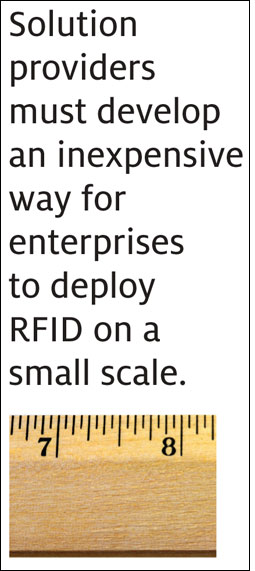Feb 01, 2012Every year for the past 10 years, prognosticators have declared: This is the year radio frequency identification will take off. While each year is marked by technology improvements and increased deployments in myriad sectors, the failure of enterprises to adopt RFID on a large scale leads to inaccurate reports about the technology's demise. So to set the record straight, we foresee 2012 as another year of progress for the industry, but RFID will not be widely adopted this year. That's because there are several things that still must happen.
1 The hardware must meet specific business needs. Over the past five years, RFID hardware has improved greatly. High-frequency systems have performed well for years. Active RFID-based real-time location systems (RTLS), which were sometimes imprecise, have improved markedly. Impinj, NXP Semiconductors and other chipmakers have developed ultrahigh- frequency chips with more functionality, and RFID vendors have used these chips to develop tags that are more efficient in retail and RF-unfriendly environments. New tags provide more accurate reads and include privacy features. Moreover, vendors have designed a myriad of specialized tags that can be used for specific purposes, such as tracking blade servers within data centers or casings in oil fields.
RFID readers have also improved in performance, but they have not evolved as rapidly as tags, in terms of new form factors for specific applications. There are essentially three types of UHF readers—fixed, handheld and mobile, which can be affixed to carts or forklifts. These work well for many applications, but there are some capabilities or form factors end users want that either don't exist or are available only from a single vendor. Some want smaller, lighter handhelds, handhelds with GPS or handhelds that are intrinsically safe (a requirement on oil rigs and in other environments where flammable materials are common).
2 The software also must meet end-user needs. Today, several companies offer robust solutions for the retail sector, but most software providers offer generic asset-tracking packages. While these packages can be tailored to track IT assets, tools in manufacturing facilities or returnable transport items, end users don't want to do a lot of customization, because it creates risk. Software providers need to tailor applications to do most or all of what an end user wants them to do.
3 The technology must reach critical mass among end users in a single industry. The industry closest to achieving critical mass is retail apparel. JCPenney, Macy's and Wal-Mart are all using RFID to track individual clothing items. Those three retailers sell billions of dollars' worth of apparel annually. Midsize chains in the United States, Europe and Latin America— including American Apparel, Banana Republic, Charles Vögele, Gerry Weber International and Liverpool—also are adopting RFID for apparel tracking. Once more retailers adopt and the industry reaches critical mass, all retailers will adopt RFID for apparel tracking because there will be less risk—the early adopters will have proved the technology is mature—and they will need to adopt to remain competitive.
Most hospitals have focused on active RTLS solutions, because better tracking of expensive equipment delivers a relatively quick return on investment. One issue slowing adoption, however, is the lack of agreement on a technology standard. Some hospitals are using Wi-Fi-based systems, while others are using ZigBee or proprietary systems. Until one solution reaches critical mass, the lack of agreement on one type of technology will foster uncertainty and risk. Hospitals do not want to adopt a system that could quickly become obsolete.
4 RFID must become easier and less risky. While technology providers tout the many benefits RFID can deliver, end users focus on RFID's risk versus its reward. Risk is inherent in the deployment of any new technology, including desktop applications such as customer relationship management software. But RFID is perceived to be particularly risky because it often involves disruption of existing processes, at least until the system is up and running, as well as new equipment to install and maintain, new data to be integrated with existing systems and other potential trouble spots.
This risk is magnified by the fact that end users often buy readers from one company, tags from another and software from a third, and then hire a systems integrator to put it all together. Vendors need to work more closely to create tightly integrated solutions that give end users confidence they will not need to spend a fortune on integration, and the systems will work as advertised without a lot of troubleshooting.
6 Suppliers must develop an easy way for end users to tag products on their own, until source tagging becomes more common. Retailers, manufacturers and logistics providers that have adopted RFID would like to receive apparel items, parts or materials, and goods they handle for customers already tagged. However, suppliers are not going to put RFID tags on everything they produce and ship unless they benefit and/or all their partners have equipment to read the tags.
Since source tagging cannot happen overnight, RFID vendors need to develop interim solutions that allow retailers, manufacturers and logistics providers to tag items they receive, so they can benefit from tracking the items internally. Right now, there is no equivalent of a price gun that lets workers slap tags on items in rapid succession.
RFID has made great strides in recent years, and we expect the industry to continue to evolve to meet many of the end-user needs described above. If that happens, 2013 could be the year RFID achieves rapid growth in retail, health care and perhaps some other sectors.


